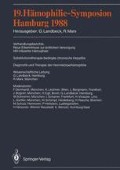Zusammenfassung
Inhibitoren gegen F.VIII-Gerinnungsaktivität (F.VIII:C) werden mit der „New Oxford Methode“ [1] oder mit der „Bethesda-Methode“ [2] gemessen. Beide Ver-fahren unterscheiden sich in der Inkubationszeit, der F.VIII-Quelle (Konzentrat oder Plasma) sowie in den Reaktionsbedingungen des Einstufentestes zur Mes-sung der F.VIII:C-Residualaktivität. Eine internationale Studie hat gezeigt, daß die Reproduzierbarkeit beider Methoden zur Bestimmung von F.VIII:C-Inhibi-toren schlecht ist [3]. Dies wird besonders deutlich, wenn die in verschiedenen Laboratorien gewonnenen Ergebnisse der Inhibitormessung in einem bestimmten Plasma verglichen werden. Ein Großteil der Unpräzision dürfte auf die schlechte Reproduzierbarkeit des Einstufentests zurückzuführen sein.
Access this chapter
Tax calculation will be finalised at checkout
Purchases are for personal use only
Preview
Unable to display preview. Download preview PDF.
Literatur
Rizza CR, Biggs R (1973) The treatment of patients who have factor VIII inhibitors. Br J Haematol 24: 65–82
Kasper CK (1975) A more uniform measurement of factor VIII inhibitors. Thromb Diath Haemorrh 34: 869–872
Austen DEG, Lechner K, Rizza CR, et al. (1982) A comparison of the Bethesda and New Oxford methods of factor VIII antibody assay. Thromb Haemost 47: 72–75
Rosen S, Andersson L, Blombäck W, et al. (1986) Clinical application of a chromogenic substrate method for determination of factor VIII activity. Throm Haemost 54: 818–823
Hellstern P, Kiel R, Miyashita C, et al. (1986) Factor VIII:C (FVIII:C) recovery and half-life after infusion of steam-treated high purity factor VIII concentrate in severe hemophilia A-comparison of one-stage assay, two-stage assay and a chromogenic substrate assay. Thromb Haemost 56: 353–359
Barrowcliffe TW, Tydemann MS, Kirkwood TBL, et al. (1983) Standardization of factor VIII — III. Establishment of a stable reference plasma for factor VIII-related activities. Thromb Haemost 50: 690–696
Author information
Authors and Affiliations
Editor information
Editors and Affiliations
Rights and permissions
Copyright information
© 1989 Springer-Verlag Berlin Heidelberg
About this paper
Cite this paper
Hellstern, P., Levi, D., Pindur, G., Köhler, M., Wenzel, E. (1989). Bestimmung von Faktor Vlll-Inhibitoren mit der „Bethesda-Methode“ mit einem Einstufentest und einem chromogenen Assay zur Bestimmung der FVIII:C-Residualaktivität. In: Landbeck, G., Marx, R. (eds) 19. Hämophilie-Symposion Hamburg 1988. Springer, Berlin, Heidelberg. https://doi.org/10.1007/978-3-642-75053-3_37
Download citation
DOI: https://doi.org/10.1007/978-3-642-75053-3_37
Publisher Name: Springer, Berlin, Heidelberg
Print ISBN: 978-3-540-51667-5
Online ISBN: 978-3-642-75053-3
eBook Packages: Springer Book Archive

